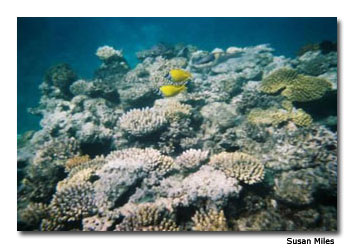
 Confession time. One of the world’s great natural wonders is literally on my doorstep, yet it’s taken this globe-trotting Australian half a lifetime to make it to the amazing Great Barrier Reef.
Confession time. One of the world’s great natural wonders is literally on my doorstep, yet it’s taken this globe-trotting Australian half a lifetime to make it to the amazing Great Barrier Reef.
In all honesty, there are coral reefs that are easier to get to, literally straight off the beach where you only need to swim a couple of strokes to be immersed in a colorful underwater world.
To reach the outer edges of the Great Barrier Reef, where the water is said to be its clearest, and thus the best to view the 200-plus varieties of coral and the more than 1,000 different species of tropical fish, your journey will take a little longer. From the major west coast cities of Melbourne and Sydney it is a 3.5-hour and three-hour flight respectively to the Far North Queensland city of Cairns.
Then, by either bus or boat, it’s almost two hours to Port Douglas, where you can board a catamaran for another 1.5-hour trip to the clear blue waters of the outer reef located approximately 20 miles (32 km) from shore.
But there is a reason that this World Heritage marine reserve is one of the seven natural wonders of the world. The sheer length, about 1,500 miles (2,300 km), covering a space half the size of Texas, is the world’s largest coral structure. It skirts the northern west coast of Australia, starting just south of the Tropic of Capricorn and ending in the Torres Strait, south of Papua New Guinea.
 |
| Visitors prepare to explore Australia’s Great Barrier Reef, a natural wonder of the world. |
For my first experience of the reef I chose to visit the Agincourt reef, a ribbon reef that appears from the deck of our approaching catamaran as a single long thin line of rippling water breaking on the horizon. Next to Uluru (Ayers Rock) and the Sydney Harbour Bridge, the Great Barrier Reef is on the “must experience” list of most international visitors to my country. The rising enthusiasm and excitement from my fellow travelers was tangible as we approached our snorkeling pontoon, making me even more self-conscious of my delay in putting the reef on my travel itinerary.
At least I was doing it right. The catamaran and pontoon comfortably accommodated 300-plus day-trippers and offered everything from fresh air helmet walks, to introductory dives, adventure snorkel tours and semi-submersible vessels to view the reef ― with and without getting your hair wet!
The not one, but two, marine biologist guides for the day were the perfect source of background information for the inquisitive reef explorer. Each year from October to December the entire reef bursts to life with the birth (spawning) of new coral across the full spectrum of coral varieties. This lunar-induced annual event produces a pungent odor that this is said to leave snorkelers and divers reeking of “stale sex.” Imagine explaining that to a spouse: “No dear, I haven’t been cheating on you, I’ve just been snorkeling on the reef!”
But besides passing on this irreverent piece of reef knowledge, our marine experts shared some of the more serious aspects of the reef. Daily monitoring of the health of the Great Barrier Reef, in conjunction with the research program “Reef Biosearch,”includes observation of the reef’s marine life, existence of any coral damage, the spread of crown of thorn starfish (the equivalent of a noxious weed to a reef) and most importantly, the presence of bleaching.
Bleaching, the casting off of algae occurs when the water temperature rises to 84-86 F (29-30 C). Coral will only grow and thrive in water of 75-78 F (24-26 C). However if the temperature goes up and bleaching occurs, this effectively starves the reef, as the coral is in fact a living organism. This shift in degrees is not a small issue. When the temperature rose to this range for a period of four months two and a half years ago, 30 percent of the coral in this region of the reef was lost. While the reef is currently considered in good health, this sensitivity to rises in water temperature designates the reef as both a victim of and a monitoring device of global warming.
 |
| This World Heritage marine reserve is the world’s largest coral structure. |
While it may have taken me a long time to getting around to seeing the Great Barrier Reef, it was well worth the wait!
If You Go
Quicksilver Cruises offer day trips to the Agincourt Reef, starting at either Cairns, Port Douglas or Palm Cove.
Tours include four hours at the Quicksilver pontoon with all snorkel equipment provided. The marine biologists guided adventure snorkel tours ― 20 minutes by dive boat from the pontoon ― are an ideal way to experience the reef and its marine life.
Best Hint: To make the most of your time on the reef, take the opportunity post-lunch (smorgasbord included) to view the reef via the pontoons semi-submersible boat before hitting the water for further snorkeling.
QuickSilver Cruises
www.quicksilver-cruises.com
Great Barrier Reef Marine Park Authority
www.gbrmpa.gov.au
Great Barrier Reef Visitors Bureau
www.great-barrier-reef.com
- Top 10 Things to Do in Ireland - April 25, 2024
- How to Get Around in Sydney: A Local’s Guide to Traveling Around Sydney - April 24, 2024
- The Low-Key Magic of Ghent, Belgium - April 22, 2024
